
To many people, The Peloponnese peninsula on the Greek Mainland is the 'real' Greece, where things have actually not altered much in any way over the centuries despite the fact that lots of people have uncovered it. This is a location where you could easily invest a month, yet if you are short promptly then our exterior searching, Fishing, totally free diving and touring Peloponnese Tours from Methoni is a terrific solution.

Searching kri kri ibex in Greece is a difficult endeavor for both neighborhood and overseas seekers. Searching large video game in Greece is restricted for overseas seekers. Wild boars and also roe deer are the only choices for local hunters apart from kri kri ibex, which might just be pursued in unique searching regions such as certain islands. In Athens, we offer the opportunity to hunt this incredible beast on two different islands that are around 150 kilometers away and 300 kilometers away, respectively. The Kri Kri Ibex and also mouflon might only be shot on unique searching areas from very early in the morning up until twelve noon, based on Greek legislation. You should book a year ahead of time for a license. Just shotguns are allowed, and just slugs might be used. Because the Greek Ministry of Nature and also Agriculture issues just a specific number of licenses each year, severe hunters are allowed on these trips.
What to Expect on a Peloponnese Tour? When you reserve one of our searching as well as visiting Peloponnese Tours from Methoni, you can expect to be surprised by the natural elegance of the area. From the pristine beaches to the woodlands and also mountains, there is something for everybody to enjoy in the Peloponnese. Furthermore, you will have the opportunity to taste some of the most effective food that Greece needs to use. Greek cuisine is renowned for being fresh and delicious, as well as you will absolutely not be disappointed. Among the best parts concerning our trips is that they are designed to be both fun and also educational. You will learn about Greek history and also society while also reaching experience it firsthand. This is an amazing opportunity to immerse yourself in everything that Greece has to use.
There is absolutely something for everyone in the Peloponnese peninsula. Whether you have an interest in background and also society or nature and also outdoor tasks, this is an optimal location for your next getaway. If you are short promptly, our hunting as well as touring Peloponnese Tours from Methoni is an excellent method to see every little thing this impressive location has to offer.And lastly, your Kri Kri ibex trophy is waiting for you.
What is the diference between Kri Kri ibex, Bezoar ibex and hybrid ibex
The kri-kri is not thought to be indigenous to Crete, most likely having been imported to the island during the time of the Minoan civilization. Nevertheless, it is found nowhere else and is therefore endemic to Crete. It was common throughout the Aegean but the peaks of the 8,000 ft (2,400 m) White Mountains of Western Crete are their last strongholds–particularly a series of almost vertical 3,000 ft (900 m) cliffs called ‘the Untrodden’—at the head of the Samaria Gorge. This mountain range, which hosts another 14 endemic animal species, is protected as a UNESCO Biosphere Reserve. In total, their range extends to the White Mountains, the Samaria National Forest and the islets of Dia, Thodorou, and Agii Pandes.
This Ibex is NOT a diminutive form of the Bezoar Ibex, which has migrated into the western-most reach of the range of this species. The kri – kri (Capra aegagrus cretica), sometimes called the Cretan goat, Agrimi, or Cretan Ibex, is a feral goat inhabiting the Eastern Mediterranean, previously considered a subspecies of wild goat. The kri-kri has a light brownish coat with a darker band around its neck. It has two horns that sweep back from the head. In the wild they are shy and avoid tourists, resting during the day. The animal can leap some distance or climb seemingly sheer cliffs.
“The agrimi goat Capra aegagrus cretica is unique to Crete and its offshore islands. It has been identi®ed as a sub-species of the wild bezoar goat Capra aegagrus aegagrus Erxleben, 1777, which it closely resembles in horn shape, body form and coloration. This classi®cation has been disputed by some researchers who claim that the agrimi are feral goats, derived from early domestic stock brought to the island by the ®rst Neolithic settlers. In order to clarify this issue, DNA analyses (cytochrome b and D loop sequences) were carried out on tissue of live and skeletonized agrimi and compared to sequences of wild and domestic caprines. Results conclusively show the agrimi to be a feral animal, that clades with domestic goats (Capra hircus) rather than with wild Asiatic bezoar. This study demonstrates that morphometric criteria do not necessarily re¯ect genetic af®nities, and that the taxonomic classi®cation of agrimi should be revised.”